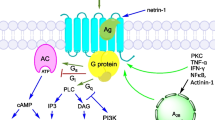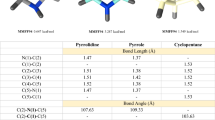Abstract
In an attempt to examine the ability of benzisothiazole-based drugs to interact with β-adreno-ceptors, a series of 1,2-benzisothiazole derivatives, which were substituted with various propanolamine or oxypropanolamine side chains in the 2 or 3 position, were synthesised and tested. The pharmacological activity of these compounds at the β-adrenoceptors was examined using isolated rat atria and small intestinal segments, which preferentially express the β1-and β3-adrenoceptor-mediated responses, respectively. None of these products showed any β- adrenoceptor agonistic activity. In contrast, the 2- and 3-substituted isopropyl,tert-butyl, benzyl, and piperonyl derivatives2a- d and3a- d elicited surmountable inhibition of the isoprena-line-induced chronotropic effects in the atria, suggesting competitive antagonism at the β1-recognition site. The pA2 values revealedtert-butyl3b and the isopropyl substituted piperonyl derivatives3a to be the most effective. Remarkably, many of the 2-substituted propanola-mines were less active than the corresponding 3-substituted oxypropanolamines. With the exception of compound3b, none of these drugs antagonised the muscle relaxant activity of isoprenaline in the intestine, suggesting no effect on the β3-adrenoceptors. These results confirm the ability of the benzisothiazole ring to interact with the β-adrenoceptors, and demonstrate that 2-substitution with propanolamine or 3-substitution with oxypropanolamine groups yields compounds with preferential antagonistic activity at the cardiac β1-adrenoceptors. The degree of antagonism depends strongly on both the nature of the substituent and its position on the benzisothiazole ring.
Similar content being viewed by others
References
Amoretti, L, Catellani, P. L, Impicciatore, M., and Cavaggioni, A., Biological properties of 1,2-benzisothiazole compounds. Local anaesthetic activity of amides and esters of 1,2- benzisothiazol-3-ylcarboxylic acid. //Farmaco, 27, 855–865, (1972).
Arch, J. R. S., The β3-adrenergic system and b3-adrenergic agonists.Rev. Endocr. Metab. Dis., 2, 385–393 (2001).
Barocelli, E., Chiavarini, M., Ballabeni, V, Mingiardi, M. R., Morini, G, Ronchini, R., and Impicciatore, M., Pharmacological properties of new 1,2-benzisothiazolyl oxypropanolamines on cardiac and tracheal β-receptors.Boll. Soc. It. Biol. Sperim., 68, 445–451 (1992).
Benfield, P., Clissold, S. P., Brogden, R. N., Metoprolol. An updated review of its pharmacodynamic and pharmacokinetic properties, and therapeutic efficacy, in hypertension, ischaemic heart disease and related cardiovascular disorders.Drugs, 31,376–429 (1986).
Bertaccini, G, Coruzzi, C, Poli, E., and Adami, M., Pharmacology of the novel H2 antagonist famotidine:in vitro studies.Agents Actions, 19, 180–187 (1986).
Blin, N., Camion, L., Magret, and Strosberg, A. D., Structural and conformational features determining selective signal transduction in the β3-adrenergic receptor.Mol. Pharmacol., 44, 1094–1104 (1993).
Candelore, M. R., Deng, L., Tota, L., Xiao-Ming, G., Amend, A., Liu, Y, Newbold, R., Cascieri, M. A., and Weber, A. E., Potent and selective human β-adrenergic receptor antagonists.J. Pharm. Exp. Then, 290, 649–655 (1999).
Coruzzi, G. and Poli, E., Changes in duodenal contractility induced by “calcium antagonists” with different modes of action.Gen. Pharmacol., 18, 69–74 (1987).
Ishibashi, T, Ikeda, K., Ishida, K., Yasui, J., Tojima, R., Nakamura, M., and Ohno, Y., Contrasting effects of SM-9018, a potential atypical antipsychotic, and haloperidol on c-fos mRNA expression in the rat striatum.Eur. J. Pharmacol., 303, 247- 251 (1996).
Kaumann, A. J. and Molenaar, P., Differences between the third cardiac β-adrenoceptor and the colonie β3-adrenoceptor in the rat.Br. J. Pharmacol., 118, 2085–2098 (1996).
Kenakin, T. P., Drug antagonism, in Kenakin, T. P. (Ed.), Pharmacologic analysis of drug-receptor interaction. Raven Press, New York, pp. 205–225 (1987).
Kusayama, T., Oka, J., Yabana, H., Adaki-Akahane, S. and Nagao, T., Binding of a catechol derivative of denopamine (T.0509) and N-tert-butylnoradrenaline (Colterol) to β1- and β2-adrenoceptors.Biol. Pharm. Bull., 17,1023–1027 (1994).
Mingiardi, M. R., Maggiali, C. A., and Ronchini, F., 1,2- Benzisothiazole derivatives potentially active as β-blockers.Ateneo Parmense, Acta Nat., 19,145–151 (1983).
Molina, E., Zappia, L, Amoretti, L, and Catellani, P. L, Biological properties of 1,2-benzisothiazole compounds. Spasmolytic activity of benzisothiazol-3-ylcarboxyamides.Ateneo Parmense, Acta Bio-Med., 45, 183–189 (1974).
Morini, G, Pozzoli, C., Adami, M., Poli, E., and Coruzzi, G., Synthesis of 1,2-benzisothiazole derivatives and investigation of their putative histaminergic activity. //Farmaco, 54, 740–746 (1999).
Morini, G, Pozzoli, C, Menozzi, A., Comini, M., and Poli, E., Synthesis of 1,2-benzisothiazolyloxypropanolamine derivatives and investigation of their activity at β-adrenoceptors. //Farmaco, 60, 810–817 (2005).
Mos, J., Van-Hest, A., Van Drimmelen, M., Herremans, A. H., and Olivier, B., The putative 5-HT1A receptor antagonist DU125530 blocks the discriminative stimulus of the 5-HT1A receptor agonist flesinoxan in pigeons.Eur. J. Pharmacol., 325,145–153 (1997).
Roberts, S. J., Papaioannou, M., Evans, B. A., and Summers, R, J., Characterisation of β-adrenoceptor mediated smooth muscle relaxation and the detection of mRNA for β1-,β1n2,-, and β3-adrenoceptors in rat ileum.Br. J. Pharmacol., 127, 949–961 (1999).
Strosberg, A. D., Structure and function of the b3-adrenergic receptor.Annu. Rev. Pharmacol. Toxicol., 37, 421–450 (1997).
Sum, F. W., Wong, V., Han, S., Largis, E., Mulvey, R., and Tillett, J., Cyclic amine Sulfonamides as linkers in the design and synthesis of novel human β3 adrenergic receptor agonists.Bioorg. Med. Chem. Lett., 13, 2191–2194 (2003).
VonFranche, A., Frickel, F. F., Gries, J., Lehman, H D., Lenke, D., and Ohnsorge, U., New β-sympatholytic agents: synthesis and pharmacological activity of isomerie benzothiazole and benzoxazole derivatives.Arzneim. Forsch. Drug Res., 30, 1831–1835 (1980).
Wadworth, A. N., Murdoch, D., and Brogden, R. N., Atenolol. A reappraisal of its pharmacological properties and therapeutic use in cardiovascular disorders.Drugs, 42, 468–510 (1991).
Author information
Authors and Affiliations
Corresponding author
Rights and permissions
About this article
Cite this article
Morini, G., Poli, E., Comini, M. et al. Benzisothiazoles and β-adrenoceptors: Synthesis and pharmacological investigation of novel propanolamine and oxypro-panolamine derivatives in isolated rat tissues. Arch Pharm Res 28, 1317–1323 (2005). https://doi.org/10.1007/BF02977894
Received:
Issue Date:
DOI: https://doi.org/10.1007/BF02977894




